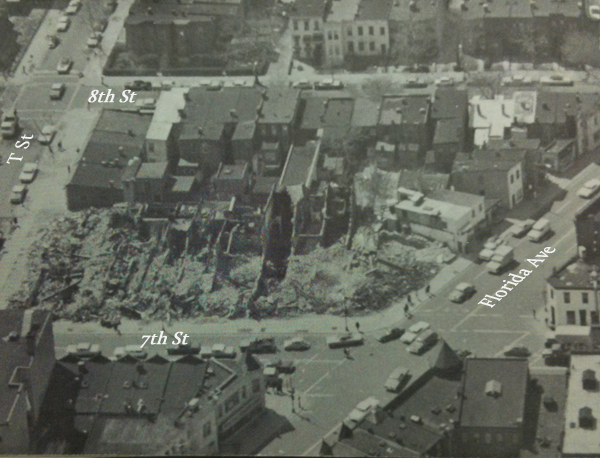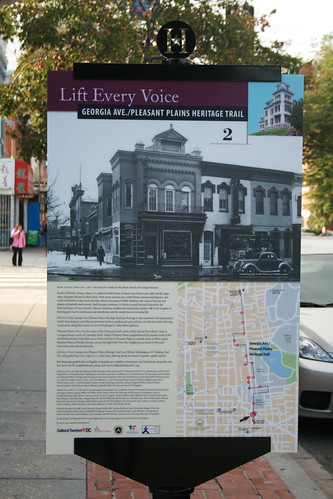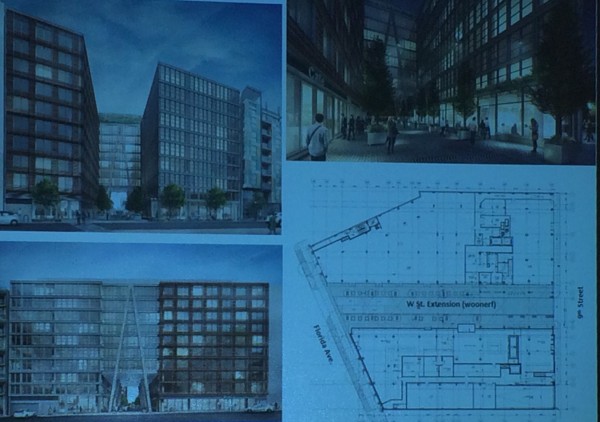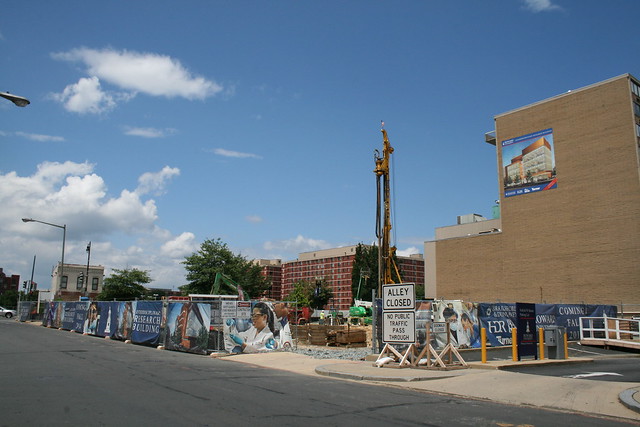HalfSmoke, LeDroit’s newest restaurant, opens on Florida Avenue

On Tuesday LeDroit Park’s newest restaurant, HalfSmoke opened at the corner of Florida and Georgia Avenues, having already received a good deal of press. HalfSmoke bills itself as a “fine casual” restaurant featuring half-smokes, which are smoked sausages made with beef and pork. HalfSmoke also serves a hybrid diner-carnival menu of milkshakes, funnel cakes, tater tots, and mac-n-cheese pops. And of course no restaurant would be viable outside of Utah without a bar.
The restaurant is the brainchild of Andre McCain, who comes to the business from investment banking in New York (now that’s a career move!). Mr. McCain has carefully curated the carnival-like experience not just with food, but also by stocking the restaurant with a free photo booth, board games, and televisions for watching sports. On my way out, I spied cornhole boards on the almost-finished patio on Florida Avenue.
You can celebrate the arrival of our newest restaurant by joining the LeDroit Park Civic Association for its monthly happy hour at HalfSmoke on Tuesday, October 11 from 6:30 to 8:30.
* * *
You may recall the building as the former home of Pharmacare, which shut down in 2013 when a Federal grand jury indicted its owner, Reddy Vijay Annappareddy, for Medicaid fraud. Although four of his employees pleaded guilty, last month a Federal judge in Maryland threw out the charges against Mr. Annappareddy.
JBG will extend W Street as a woonerf
JBG revealed more plans for the residential development it plans to build at 945 Florida Avenue NW. This is the site abutting the 965 Florida Avenue, which is slated for a Whole Foods. 945 is slated to be a multifamily building, which is not surprising, but the developer has opted to extend W Street one block from its current terminus at Florida Avenue NW to Ninth Street NW.
The W Street extension has been a long-standing goal of neighborhood planning efforts as there are currently few east-west connections between that section of Florida Avenue and Georgia Avenue. Smaller street grids make walking easier as there are fewer “superblocks” to walk around.
The new one-block extension will be privately built, owned, and maintained. It will be constructed as a woonerf, a street where automobile and pedestrian traffic share the same space. The best example of a woonerf in the area is Cady’s Alley in Georgetown.
The developer is building the project matter-of-right.
1925 photo of Griffith Stadium also shows LeDroit Park
Every time I come across a photo of Griffith Stadium, which stood where Howard University Hospital now stands, I look carefully for an angle of LeDroit Park. By way of Ghosts of DC comes this superb 1925 aerial shot looking north at the stadium and part of the neighborhood.
The east-west street in the foreground is the 500 and 600 blocks of U Street NW. Zoom in and look around. Notice the streetcars on Georgia Avenue in the upper-left corner of the photo. Notice the previous incarnation of the Florida Avenue Baptist Church in the lower-left corner.
The stands beyond Griffith’s straightaway center field backed up to 5th Street from Elm to V Streets. Can you imagine hearing the crack of a bat and roar of crowds during a Senators game?
Also note what’s no longer standing. All but seven houses pictured east and north of the stadium have since been demolished, replaced with parking garages, parking lots, public housing, or academic buildings. Nearly all of these houses would be illegal to rebuild today under our 1950s zoning code, which mandates minimum lot sizes and house widths to which much of historic LeDroit Park does not conform.
Photo source: National Archives
Pharmacare closed; owner indicted for fraud
PoPville reports that Pharmacare, the pharmacy at Florida and Georgia Avenues has closed permanently after its owner was indicted for fraud.
The U.S. Attorney alleges that the owners of the Pharmacare and several affiliated pharmacies in Maryland and Pennsylvania billed $2.6 million to Medicare and Medicaid for prescriptions they never actually refilled. A sign posted on Pharmacare’s door says the store has closed as of August 2.
Is Howard University in financial trouble?
Over the past few months, reports have trickled in warning about Howard University’s fiscal health. The news is not good. The school’s enrollment had dropped, its annual Congressional appropriation has fallen, and the hospital is furloughing workers to make up for large losses. On the bright side, Howard’s capital improvement program is underway and several cranes tower over three active construction projects on the campus (more on that later).
As for fiscal issues, the first warning came in June, when a Howard University trustee warned, “Howard will not be here in three years if we don’t make some crucial decisions now.” Whether the trustee was exaggerating Howard’s fiscal straits due to internal politics remains unknown, but a potential sequester of the university’s Congressional appropriation adds to the unease.
Since its founding in 1867, Howard has received an annual appropriation from Congress much the way state universities receive appropriations from their state legislatures. The appropriation has remained steady over the past few years, but sequestration is expected to reduce the amount. Federal funding accounts for a sizable 27% of the university’s operating budget, meaning any change will be noticeable.
Furthermore, the recession, which hit black Americans especially hard, is often cited as a major factor contributing to last year’s 5% enrollment decline, further depriving the university of tuition revenue. Tuition for the 2013-14 academic year is set for $22,783, excluding housing, a difficult stretch for most families.
In June the university announced it would layoff 75 employees and earlier this month, the hospital announced it will furlough 1,700 staff for eight days. The hospital has suffered a sharp decline in patients and revenue.
Money problems are nothing new at Howard. In fact, tight university finances are a theme that appears in The Black Apollo of Science, the biography of Ernest Everett Just, a 1920s and ’30s Howard biology professor and LeDroit Park resident. The university has survived tough times before and it is rare for large universities in the U.S. to shut down.
Some of the bad news is more than just financial. Late last month, news leaked that the university and its development partner had parted ways on the Howard Town Center project, further delaying the mixed-use development project the university has been planning for years.
Lift every crane and build
But there’s good news, too! Visit LeDroit Park’s newest Capital Bikeshare station and you’ll spot the cranes that tower over the Howard campus. In fact, the university is currently constructing three new buildings: two new dorms on 4th Street and an interdisciplinary STEM research building at Georgia Avenue and W Street.
The two dorms at 4th and College Streets NW and 4th and W Streets NW are part of the university’s plan to improve and increase on-campus housing. By making 4th Street NW a residential spine, the university hopes to keep its students in newer buildings physically close to academic buildings. The proximity is expected to boost academic performance and the newness of the housing is expected to attract top-performing students.
Here is a photo of the new dorm now under construction at 4th and College Streets NW:

When finished:

Design of the new Howard University dorm at 4th and College Streets NW.
Here is a photo of the new dorm now under construction at 4th and W Streets NW:

When finished:

Design for the new Howard dorm at 4th and W Streets NW
At Georgia Avenue and W Street, Howard is constructing a new building for STEM research. The new high-tech facility is expected to boost the university’s research profile and its ability to win research grants that require advanced research facilities. The LeDroit Park Civic Association supported the zoning relief necessary to build this building.
When finished:
Though the university’s fiscal woes make headlines, several important capital improvements are well underway.
Trader Joe’s coming to 14th & U

It looks like 2013 will be a harvest year for LeDroit Park residents as two new grocery stores open nearby. DCist broke the news that Trader Joe’s will open a store at the Louis building now under construction at the southwest corner of 14th and U.
Located at just under a mile’s walk from Anna J. Cooper Circle, the new store will provide another grocery option to area residents.
TJ’s prices are competitive with many other stores and the TJ’s specializes in unusual and somewhat exotic foods in addition to the usual staples. TJ’s main weakness lies in its produce selection, which, judging from experiences at the Trader Joe’s in the West End, is limited.
The store’s opening next year will also be accompanied by the opening of the 60,000 square-foot Giant at the CityMarket project at 7th and P Streets in Shaw. Once these two projects open, all the major grocery store chains in the area will be located no more than 1.1 mi. from LeDroit Park.
| Store | Location | Distance (mi) |
|---|---|---|
| Giant (opening 2013) | 7th & P Streets NW | 0.6 |
| Trader Joe’s (opening 2013) | 14th & U Streets NW | 0.9 |
| Safeway | 5th & L Streets NW | 0.9 |
| Harris Teeter | 1st & M Streets NE | 1.0 |
| Whole Foods | 1400 blk. P Street NW | 1.1 |
Even still I dream of a full-service grocery store opening up at the long-stalled Howard Town Center project at Georgia Avenue and V Street. The project, in the planning stages for many years, has been perpetually delayed by disagreements between Howard University and its development partner.
The UPO building on Rhode Island Avenue used to be a Safeway many years ago. The site is large enough to be redeveloped into a modern, urban grocery store if parking is placed underground. In fact the second floor could house UPO’s offices.
Until those dreams come true, the nearest full-service grocery stores are a long, but manageable walk.
7th & Florida in ’68, ’88, and today

What happened to all the historic buildings at 7th Street, Florida Avenue, and Georgia Avenue? We all recognize the CVS and its adjacent parking lot. As we reported before, the adjacent grassy field is slated for a residential development by JBG, one of the region’s largest development companies.
But how did the CVS, the parking lot, and the grassy field get there in the first place? They are the consequence of the 1968 riots and of the construction of the Green Line tunnels.
The riots of April 1968 destroyed many of the buildings along 7th Street. A few months ago we came across this photo in a Congressional report published in the wake of the riots. The west side of 7th Street from T Street to Florida Avenue was obliterated:

Decades later, the intersection sat at an elbow in the proposed Green Line tunnel. The subway line curves from 7th Street to Florida Avenue and then to U Street. Much of the line was constructed using the cut-and-cover method, which requires razing buildings, digging a trench, building a concrete box in the trench, and covering it back over.
Subway tunnels typically run under existing streets, but sharp changes in direction require cutting corners and thus the creation of tunnels where buildings often stand.
A 1988 photograph shows the construction of the Green Line tunnels, which pass under the CVS and adjacent lots.

What the riots didn’t destroy, the Green Line took care of.
Howard Theatre encourages private parking
To reduce the liklihood that patrons will park on residential streets around the Howard Theatre, the theatre will sell prepaid private parking through Ticketmaster. The passes are for private lots owned by Howard University and other private owners.
In fact, we were looking on Ticketmaster at prices and availability for April’s Wanda Sykes show and spotted this prominent parking add-on at the bottom:

The lots described above are as follows:
- Valet shuttle Lot B – Howard University’s large parking lot at Georgia Avenue and W Street.
- Self-parking Lot A – Howard University’s HURB-I parking lot at 7th & T Streets.
- Premier Valet – private triangle lot at T Street and Florida Avenue, across from the theater.
When Progression Place, the office and apartment project at the Shaw Metro, finally opens, the theatre will lay claim to a significant number of the project’s underground parking spaces during nighttime hours, thus adding a another option.
Neighboring heritage trail opening soon
 Cultural Tourism DC is finishing the installation of the signs for the Georgia Ave./Pleasant Plains Heritage Trail. Here is one we spotted outside the Dunbar Theater (now Wells Fargo bank) at 7th and T Streets NW.
Cultural Tourism DC is finishing the installation of the signs for the Georgia Ave./Pleasant Plains Heritage Trail. Here is one we spotted outside the Dunbar Theater (now Wells Fargo bank) at 7th and T Streets NW.
The trail opening event will be on Saturday, October 15 at 11 am at the plaza in front of Howard University Hospital.
Work on the heritage trail for LeDroit Park and Bloomingdale has progressed greatly and we are on our way to having our own trail to honor LeDroit Park’s rich history.
Howard faces dilemma with mixed-use development
Plans for Howard University’s proposed mixed-use development project, Howard Town Center, have been dragging on for years. The university is making the tough call to hold out for the ideal project rather than build what it can in this investment climate.
Troy Stovall, Howard University’s chief operating officer, revealed Thursday that the difficulty in financing the project is not due to the retail and supermarket component, but due to the number of apartments slated for the site.
Rather than letting the developer proceed with building the garage, supermarket, retail shops and half the number of apartments originally planned, Howard wants the full project, including all of the apartments built into project at the same time.
When asked on the status of the retail component, Mr. Stovall said that the developer has received several letters of intent from supermarkets interested in the space. The problem, though, lies upstairs. The banks, Mr. Stovall stated, are less convinced about the financial viability of building so many apartments on lower Georgia Avenue.
U street developer JBG, however, has recently purchased several properties within a few blocks of the Howard Town Center site. JBG and Howard’s banks clearly differ in confidence in the area’s potential.
Is Howard letting the perfect become the enemy of the good? Neighbors appear to strongly support the arrival of a supermarket, especially since the closest one, a mile away, offers a paltry selection.
However, to abide by the banks’ requirements to reduce the number of units reduces the viability of the area’s retail revitalization. More residents, after all, means more potential customers, and thus more chances for success along Georgia Avenue.
It’s certainly debatable as to whether the delay in the arrival of a grocery store is worth the slowing of Georgia Avenue’s revival. One the one hand, Howard’s desire for delayed gratification will make the avenue’s retail revitalization more durable. On the other hand, holding out for the ideal project postpones a catalyst for the avenue’s revival.














Recent Comments